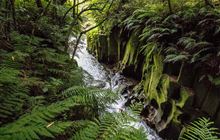Kiwi calls fill the night in Whirinaki Te Pua-a-Tāne Conservation Park
Archived content: This media release was accurate on the date of publication.
Introduction
New survey results indicate the kiwi population in Whirinaki Te Pua-a-Tāne Conservation Park is growing.Date: 08 November 2019
Two separate acoustic recorder surveys, one in the Whirinaki River valley and one in the Mangamate Stream valley, have both shown a marked increase in kiwi calls from 2013 to 2019.
DOC rangers used acoustic recorders to capture kiwi calls over a series of nights; calls recorded in the Whirinaki River valley increased from 27 to 50 (85% increase). In the nearby Mangamate Stream valley calls increased from 158 to 285 (80% increase).
The increases in kiwi calls coincide with three large scale Tiakina Ngā Manu/Battle for our Birds aerial 1080 operations). The first major operation was in 2012 followed by another in 2015 and most recently in 2017. While the kiwi in the Whirinaki River valley benefit from a trapping regime established to protect whio in addition to aerially laid toxin – the Mangamate Stream valley results are particularly exciting because this valley is only protected by aerially laid toxin.
The growth in kiwi numbers, along with a bumper season of whio breeding earlier in the year, have DOC biodiversity supervisor David Wills ecstatic. “It’s been amazing seeing the changes in the forest over time; to see threatened species thrive and have their numbers increase is really rewarding. Both trampers and trappers are noticing more kiwi sign on the tracks and hearing more kiwi calls while staying in the huts and campgrounds.”
Ngāti Whare, who jointly manage the park with DOC, have also noticed positive changes in the ngahere (forest). Te Runanga o Ngāti Whare chairman DS Carson said the results of this survey endorse the runanga’s support of DOC and its pest control management practices. “The abundance of taonga (treasured species) in the Whirinaki is a tohu (sign) that our kaitiakitanga (guardianship) is alive and well.”
With so many amazing native New Zealand species thriving, the park provides ample opportunities for nature lovers. In addition to more than 100 km of tramping tracks and nine huts, the Whirinaki Te Pua-a-Tane Conservation Park also has a number of accessible short walks. The Sanctuary Track/Whirinaki Night Life Walk is a prime spot to listen out for the call of the kiwi.
To plan your next trip visit: www.doc.govt.nz/whirinaki
Contact
For media enquiries contact:
Email: media@doc.govt.nz

